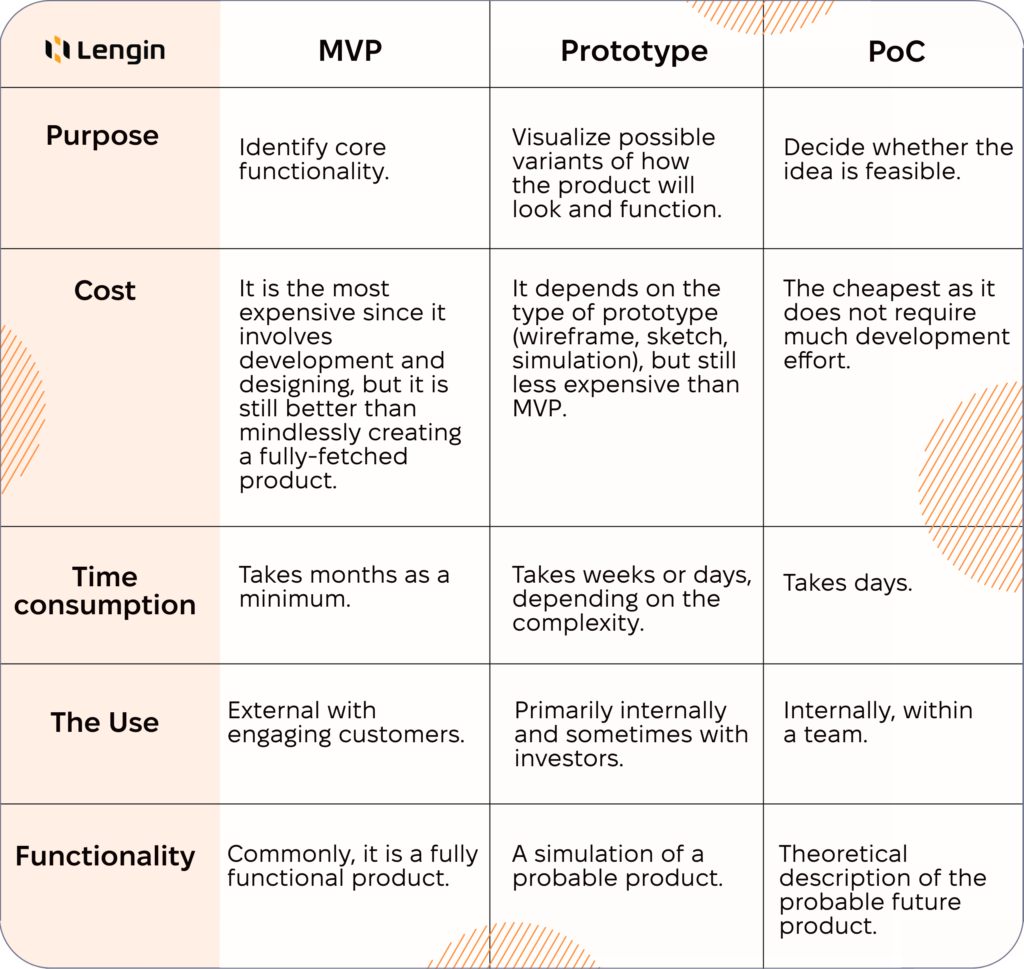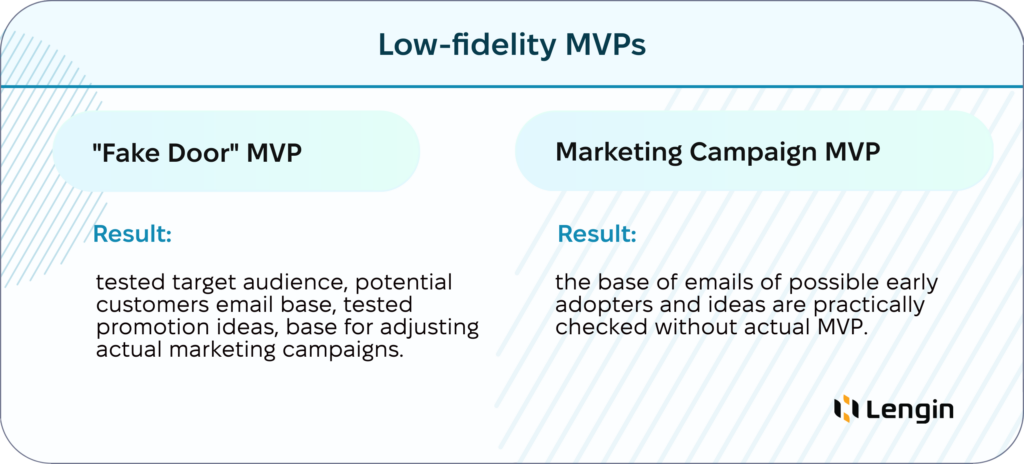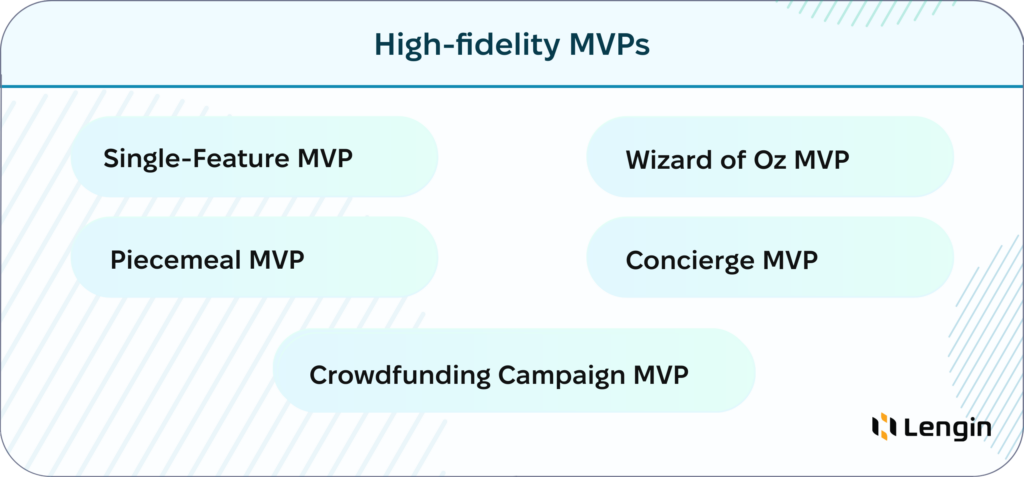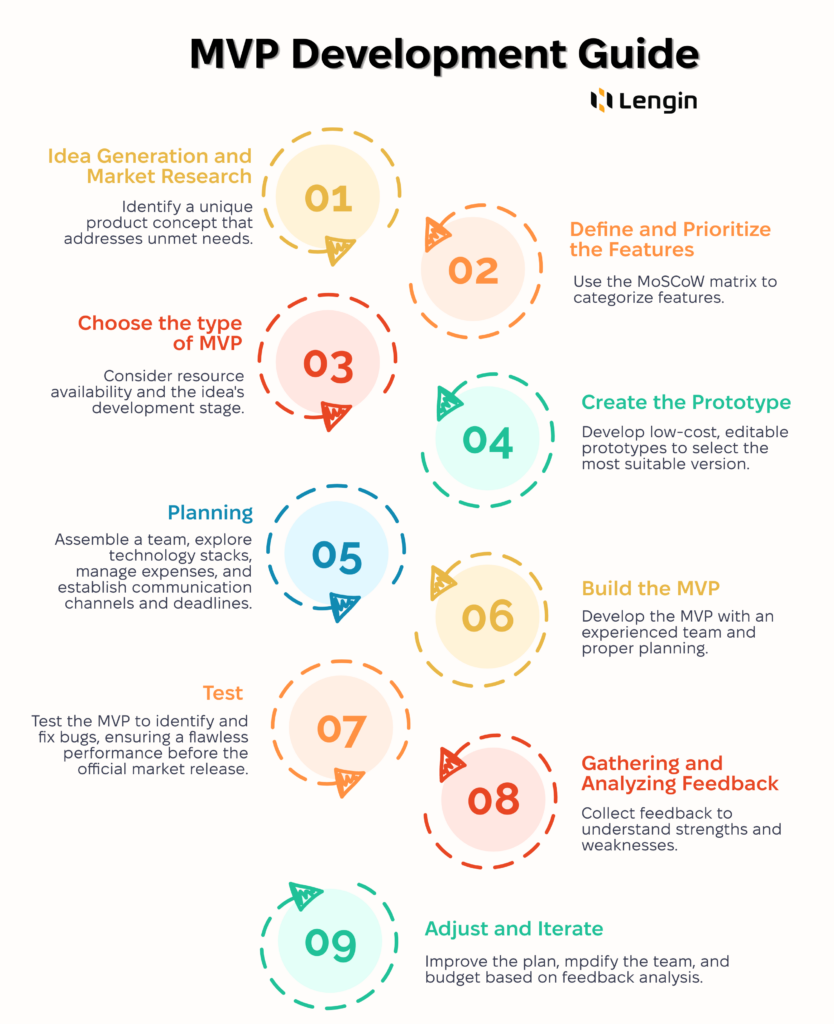MVP stands for Minimum Viable Product – the first barebones version of a product launched quickly to gain early feedback from customers to validate an idea, identify what features are most important, and guide subsequent product development.
Some characteristics will help you understand what a good MVP is:
- Has only essential features without additional benefits.
- Solves a real problem.
- Built with speed in mind.
- Leads to the next version.
According to that description, MVP might be confused with a prototype or proof of concept. Therefore, there is a table that will help you with the differences.
Table of Contents:
PoC vs. Prototype vs. MVP

Types of MVP
There are a few types of MVPs that can be combined or changed and sorted into two categories: low-fidelity and high-fidelity. Each type will be suitable for different kinds of products and budgets.

Low-fidelity MVP

“The Fake Door” or Landing Page MVP
“The Fake Door” is “MVP before MVP” for demonstrating the core concept in a way that generates feedback and reactions from potential customers as quickly as possible without creating an actual product.
You can determine if there is genuine demand for your product idea before investing heavily in development. Also, The Fake Door MVPs require minimum action and can be created in days or weeks compared to fully functional products that take months.
For instance, the landing page advertises the functionality of the future product, offering not only core features but also some premium plans or a demo. After pushing any button, the customer is redirected to the page informing that the product is under construction and offers to leave an email for further notification about the release.
Result: the base of emails of possible early adopters and ideas are practically checked without actual MVP.
Marketing Campaign MVP
Another type of MVP used for estimation of the customer’s interest in your product is Marketing Campaign MVP. Email Marketing is one of the most efficient options. You will be able to receive emails from your potential customers and so gather the early adopters base. Also, this type of MVP allows marketers to experiment with new strategies or channel combinations in a limited, low-risk way before committing large budgets.
Result: tested target audience, potential customers email base, tested promotion ideas, base for adjusting actual marketing campaigns.
High-fidelity MVPs

Single-Feature MVP
It is what it sounds like. Single-Feature MVP includes only one function that is supposed to solve the problem and is used for hypothesis validation.
A Pre-Order or Crowdfunding Campaign MVP
This type of MVP is a practical way to raise funds for developing fully-fetched products. It can operate as a single-feature or “The Fake Door” MVP with the option to pre-order or donate.
Concierge MVP
The Concierge MVP simulates a multifunctional product, but a human performs its primary functions.
Rather than building an actual product, employees manually perform the desired product or service functions for a few early customers.
That is the fundamental characteristic of Concierge MVP – engaging as minimum numbers of users from your target audience as possible. This way, the number of employees required for this will also be minimal. Interacting directly with customers and fulfilling their needs provides immediate feedback on what is most important and valuable and what is lacking.
Nevertheless, customers have to know that work is performed manually, and this solution is only temporary. Validated knowledge should help build an actual product or automate the processes.
For example, Zappos, one of the most popular retail platforms in the US, was born as a concierge MVP shoes store.
Wizard of Oz MVP
Another type of MVP that pretends to be fully-functional AI, software, robot, or system, but most of the features involve people “behind the scene” or are under construction. In contrast with Concierge MVP, customers need to be made aware of the fact that the product is not ready.
Piecemeal MVP
A Piecemeal MVP involves launching different parts or features of a product independently and incrementally to test and validate them separately before integrating them into a unified whole.
The concept of this MVP is built on the principle of “divide and conquer.” You divide the product into pieces of functionality, test each with different target audiences, on different markets, via different channels, and gather versatile feedback. The best part is that this way, you will put aside some features that would be irrelevant but costly.

MVP Development Guide
Unfortunately, creating the MVP does not consist of one just-build-as-is step but is preceded by elaborate preparations.
1. Idea Generation and Market Research
The concept of the product must either relieve some pain points that existing solutions can’t or facilitate those processes. Market research aims to find the problem for your solution, people who are interested in it, and competitors that already hold a market share. Many ideas do not survive this phase, and that is for good.
2. Define and Prioritize the Features
“1.0 is not all your ideas; it’s simply what made the first cut. This is one of the most frustrating things about a 1.0 – it’s not everything you wanted to do, and you can’t wait to dive back in to build more stuff. Always a wild mix of excitement and frustration.”
Jason Fried
MVP includes only core functionality, no premium features, no nice-to-have, and no personalization. That may become a real challenge because you often want everything at once. An excellent approach to use in this case is the MoSCoW matrix.
It sorts out possible features into four categories: must have, should have, could have, and will not have. The “Must Have” section is the functionality of your MVP that can include some of the features in the “should have” section.
Nevertheless, the “could have” and “will not have” sections are not going to be presented in the first two or three versions of the product. If the “will not have” section is empty, reconsider your choices.
3. Choose the type of MVP
Low-fidelity options are worth considering when resources are severely limited and you are not entirely sure of the idea. High-fidelity MVP requires much time, money, and resources, so it is suitable for cases when the idea has successfully gone through the Proof of Concept. Choose the type of MVP that suits you the most.
4. Create the Prototype
Prototypes are low-cost, easily editable mockups that will help to understand the workflow and design architecture. The best part is that you can have several prototypes and choose the most suitable one for almost no cost.
5. Planning
The planning stage includes a few steps. The first one is understanding who you need. It is impossible to build MVP on your own; you need a team. Find information about the development process, read about various advantages and disadvantages of different tech stacks, and make some notes about what you think would be suitable.
Think over your expenses that will not run your budget dry at the very first iteration. Based on your calculations, consider different ways of hiring professionals or outsourcing. Staff augmentation offers various solutions and guarantees the high-quality delivery of discussed services.
The next step in planning is establishing the channels of communication, tracking results, and deadlines. A skillful project or product manager is the person whom you need to avoid drowning in all the processes required for your product development.
6. Build the MVP
Creating the actual MVP is not the easiest task. An experienced team and proper planning pave the way for smooth development, but hidden risks are always there. That is why development may take more time than planned.
7. Test
Before the actual release on the market, test the product with an internal team. This will be the first time your idea will face the world, and it must work perfectly. This stage aims to find and fix bugs early.
8. Gathering and analyzing the feedback
There are two types of users: the one who uses the free version and praises your product and the one who is ready to pay for it and they are merciless. The negative feedback is the most valuable one because it shows the way to further improvement and user satisfaction, and analysis gives an understanding of the further objectives.
9. Adjust and Iterate
After analyzing the feedback and understanding the gaps that your products do not fill, you should adjust the plan and the team for the text sprint. Adjust the budget and requirements accordingly and then leave those team members who are necessary for the project’s current stage. Staff augmentation is a flexible solution, so there would be no problem.
Start over. Iterate. Never stop improving.

Why does MVP fail?
According to the U.S. Small Business Administration, only about 50% of startups survive for five years. The reasons are various, but those three are the most deadly for the project.
No marketing need
Everything has already been invented, and there is no space for novelty. Even so, the big market is not as scary as it looks. Products that target a large market don’t usually start by boiling the ocean. They build incrementally after finding a hugely valuable solution to a single pain point.
Unfortunately, sometimes the solution already exists, and there is no point in creating the same but with one additional function or better design. Admit it, or you will be among those 35% of startups that fail because of no market need.
Insufficient marketing
When you find the gap in the niche and relieve a real pain point, the next step is promotion. Start with the question, “Who can benefit from my product?” The answer is your target audience.
Almost half of MVPs fail because of inefficient marketing strategy, incorrectly identified target audience, or inability to reach the target audience with done marketing efforts. Proper promotion is a complex long-run process of assuming, testing, analyzing, and iterating all of the above. Neglecting it will lead to the world never having a chance to find out about your product.
Ignoring the feedback
MVP provides you with valuable feedback from your audience, and the worst that you can do is neglect it. Many creators tend to believe that after all the struggles, theories, and efforts, their MVP is perfect, but unfortunately, it is not. Neglecting customers’ opinions results in decreased satisfaction and, consequently, no sales.
Those mistakes above are the most common, but there are a lot of factors that have an impact on the success of MVP. It would be better to consider failed MVP cases to learn from their mistakes.
Business Cases: Unsuccessful MVPs
Have you ever heard about Google Buzz? Or Beequick? Quibi? Exactly! All these names are examples of failed MVPs. Now, we can analyze their mistakes and learn from them.
Google Buzz
Have you ever heard about Google Buzz? Exactly. It was supposed to be the competitor for Facebook in Twitter, announced in 2010.
Although Google is a large corporation that invested tremendous amounts of resources in this MVP, Google Buzz failed due to no market need. Facebook and Twitter had already covered most of the market, so Google Buzz did not find its audience. Perhaps, Threads are bound to meet the same fate.
Nevertheless, MVP was released the same year and met with mixed reviews. After analyzing controversial feedback, Google shut down the project in 2011.
Moral of the story: market research and solving real problems is a must for a successful MVP.
Beequick
Beequick was an O2O grocery booking service that offered delivery of fresh food and other products from thousands of stores within an hour. The company was founded in 2014 by two brothers, David and Michael Chen.
The story began in Beijing, China – the city with one of the craziest traffic in the world. Also, employees in China, who work according to a 9-9-6 schedule, can’t allow wasting their precious time on grocery shopping and traffic jams. This way, Beequick found its target audience and raised $110 million in disclosed funding.
It expanded to other cities and had great success but only went beyond its MVP. Design and functionality remained the same even after three years. The same year Beequick crashed, the top management left the company, and it was the beginning of the end.
Now Bequick is unavailable on any existing platforms for mobile app downloads.
Moral of the story: First, the minimum viable product is literally the minimum of what it is supposed to be. Nice MVP is the first step to a successful outcome. Constant improvement is a necessity to keep up. Second, management is essential. If you do not have leadership, hire the talent that can handle it.
Quibi
Quibi is a short-form video streaming service designed for use on the phone. The idea was based on the concept of breaking down long films or series into short pieces that are convenient to watch during the commute on mobile phones. It was founded by Hollywood executive Jeffrey Katzenberg and former HP CEO Meg Whitman, with $2 billion raised before Quibi even launched.
Nevertheless, Quibi is now known as the short-form streaming service with the shortest run of all – barely more than six months. What are the reasons?
1. Terrible content for too high a price is how to get people interested and make them pay first, but not keep them. The idea is the engine, but poor execution and unreasonable charges will kill even the most brilliant concept.
Lengin is ready to help you with execution! Our talented developers have brought to life many successful projects, and you can be the next. Let’s discuss the opportunities for partnership and growth.
2. Poor marketing strategy is one of the deadly stumbling blocks of many entrepreneurs. The only promotion Quibi got was Twitter, which is apparently not enough. Marketing is necessary so your idea is heard and recognized.
3. Life changed, but Quibi didn’t. The world was immersed in the pandemic, and commuting as a part of daily life was eliminated. Since Quibi initially aimed toward commuters as a target audience, Covid-19 became a challenge that could be partially overcome by adding support for Apple’s AirPlay and Google’s Chromecast.
If Quibi had made a single upgrade with the function of making screenshots, it would have contributed to a meme culture, which probably would have allowed it to last a bit longer. However, Quibi was born and died the same.
Therefore, improvement is everything.
Business Cases: Successful MVPs
Every big successful project was a minimum viable product once. A few real-life cases that you definitely have heard about will show how to start to reach the top.
Airbnb MVP story
Airbnb is the most popular website for online accommodation booking, which started with two poor designers who allowed strangers to sleep on the air mattresses in their living room. In 2007, AirBed&Breackfast started as a tiny website without even functions of pricing and paying because Brian Chesky and Joe Gebbia knew that feature-rich failure is more painful, costly, and time-consuming.
Founders tested their theory with visitors of a big conference in San Francisco that made all the hotels fully booked. And they found three people ready to pay 80 USD per night to sleep on the air mattresses. This way, they found the gap in the niche, validated their hypothesis, gathered feedback from the early adopters, and raised the first 240 USD for the further development of their product without costly solutions. That is how MVP works.
Today Airbnb is a versatile platform for booking accommodation of various types with a search engine, filters, payment systems, and high-security measures.
Uber MVP story
Another successful MVP launched in San Francisco. World-famous car-sharing service in 71 countries started with three cars and a simple app for iPhone called “UberCab.” Functionality was basic: push the button – get the car.
Live-tracking of drivers, linking to mobile wallets, fare splitting, automatic credit card payments, fare estimates, and many other functions were added gradually after Uber MVP gathered enough feedback and raised 1.25 million USD.
Spotify MVP story
In 2006, Spotify launched a peer-to-peer music file-sharing application Spotify AB that allowed users to search for songs and play them on their computers. It had been on the market for a few months before the product launched in 2007.
This simple implementation of the idea that music lovers want to listen to it all the time, everywhere, allowed Daniel Ek and Martin Lorentzon to find the opportunity to create something new in the music industry. They received unexpected popularity and decided to enhance MVP and continue working.
“We spent an insane amount of time focusing on latency when no one cared because we were hell-bent on making it feel like you had all the world’s music on your hard drive. Obsessing over small details can sometimes make all the difference. That’s what I believe is the biggest misunderstanding about the minimum viable product concept. That is the V in the MVP.”
Daniel Ek
Today, Spotify has over 517.69 million users worldwide and over 80 million songs.
Moral of the stories: start with something small to validate the hypothesis and then build the idea up. The long journey begins with one step – MVP.
Conclusion
MVP is an essential step to launching the actual product. A wide variety of types allows choosing the suitable one according to given requirements and resources. The most significant advantage of using MVP to validate the idea and gain an audience is that it is cheaper and less time-consuming than building costly multifunctional products.
Since more than a quarter of startups fail because of no market need, creating MVP should be started from market research. Also, MVP development includes such stages as defining and prioritizing features, choosing the type of MVP, creating prototypes, planning, testing, and constant improvement.
All successful products start from the simplest Minimum Viable Product. Along with successful examples, there are many failed ones, and that’s a chance to learn from their mistakes.
If you need professional help with developing your MVP, contact us!